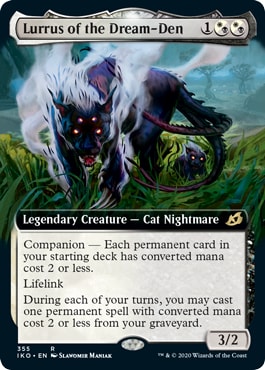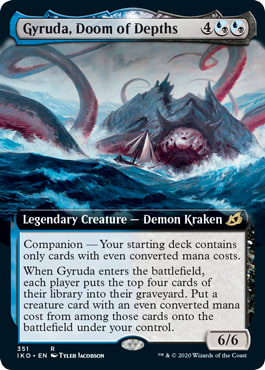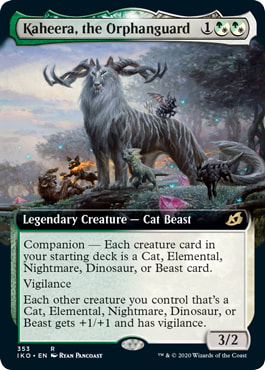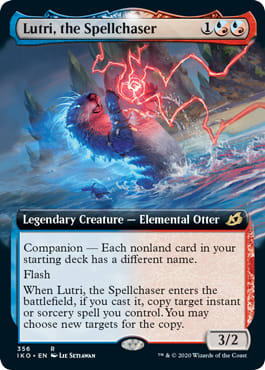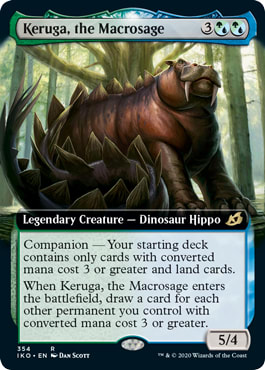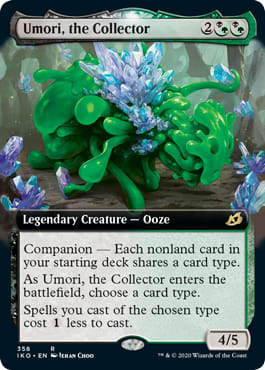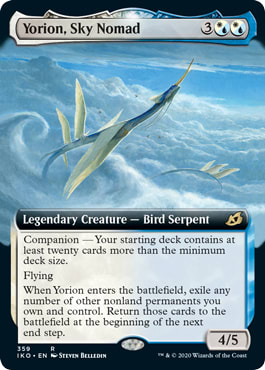While Ikoria's companions are currently embarking on a reign of terror across every single Constructed format and grabbing all the headlines, lost in the mix a bit is a resurgence in the popularity of booster draft.
Now, of course, a large part of this is the long awaited release of real 8-player drafts on MTG Arena rather than bot drafts, but it is heavily bolstered by the fact that that Ikoria: Lair of Behemoths is one of the best Limited sets in a very long time. The set is high powered, but because of an exceptional balancing act of different mechanics and synergy tension almost every draft is a unique and challenging experience.
Okay, the cycling deck is a little too good, but the beauty of real player drafts instead of bot drafts is that people are self-correcting. Getting an awesome cycling deck two weeks ago wasn't hard, but the secret is out. Mutate is a phenomenal limited mechanic, forcing you to ask yourself tough questions with every creature you play, and there are so many little subthemes that watching them intertwine is fascinating.
And that's not even discussing companions!
While companions have proven easier than anticipated in Constructed, they present quite the challenge in a booster draft. Rather than every single card in a format, you are only allowed the 45 cards you draft to try and meet the deck-building requirements. If you can meet them, the payoff is huge; starting every game with an 8th spell in your hand is a monumental advantage in a game of Limited, where a random 5/5 creature can really swing a game. But it can also mean passing up on great cards to try and meet the requirements.
Companion Basics
Despite the challenge and downsides, having a companion is a huge advantage.
If you open a companion in your first pack, taking it and building around it should be a priority for all but the most challenging companions. Even the more difficult companions are all great cards to play straight up even if you don't end up companioning them, so the risk is low.
I'll say this one more time because it's so important: Starting a game of Limited already up a good spell on your opponent (assuming they don't have one too) is a monumental advantage and one that you should be trying very hard to work towards. This also includes if you are passed a companion in one of your first few picks, or you open a companion in pack two that you've already got a good basis for.
Understand that you are going to start most games up a spell on your opponent and build your deck accordingly. This means you can go a little heavier on land, while also a little lower on your creature count because you know you've always got access to one. This also means that creature recursive effects that you'd worry about being dead in the early game if you don't draw good creatures are much better than usual, as you'll always have a companion to get back. Don't get run over, allow your companion to come play, and utilize the card advantage and quality you gain to claim victory.
It's also important to note how having a companion affects the gameplay of your opponent. If they know your deck-building restriction, they know what cards it's not possible for you to be playing. No reason to play around Blood Curdle if you're playing Obosh, the Preypiercer or a second Essence Scatter if you're playing Lutri, the Spellchaser! Furthermore, they know what point in your mana curve is most important and can leave up reactionary spells as needed. Essence Scatter is the most clear, but even just holding up a removal spell for the turn you cast Kaheera can be obvious. Do what you can to not play into cards like this if you have other options and make them keep leaving mana up.
That all being said, today I'll be going over each companion in the set in difficulty order, starting with the easiest, and explaining what you need to do with your draft to maximize your companion and overcome the deck-building restriction. Your pick orders will have to be shifted, sometimes wildly, based on the restrictions the companions create, which often creates very interesting deck-build puzzles that reward outside the box thinking.
I'll also be providing a sample decklist for the ones I have personally played with, with a little help from some friends for the two I haven't.
While Jengatha offers perhaps the least exciting body and effect out of all the companions, it is also one of the best because of how easy the deck-building requirement is. As a set based around three color wedges, there aren't too many double colored cards in the set and ignoring them is well worth the payoff of a very solid 8th card in hand. Jengatha is also very easy on the mana, fitting into any Green or Red deck, even on a splash. Jengatha's ability isn't irrelevant either, as you can use the burst of mana to empty your hand while also giving it utility if it's hit by Pacifism.
Because of how simple Jengatha's requirements are there really isn't much to say here. You're very happy if you open Jengatha, and even if you open or get passed one later in the draft it's not hard to make it work. Even if you have to leave a good card or two on the bench like I did in this draft, abandoning a somewhat hard to cast Luminous Broodmoth, the reward is well worth it.
Jengatha To-Do List:
- Draft normally and don't take double color cards
- Don't be afraid to splash Jengatha
- Don't pass Jengatha if you are even remotely close to casting it unless you have multiple double cost bomb rares
Jengatha Example Deck | MTG Arena Draft | Jim Davis
- Companion (1)
- 1 Jegantha, the Wellspring
- Creatures (16)
- 1 Dreamtail Heron
- 1 Farfinder
- 1 Glimmerbell
- 1 Pollywog Symbiote
- 1 Splendor Mare
- 1 Wingfold Pteron
- 2 Parcelbeast
- 2 Thieving Otter
- 3 Frost Lynx
- 3 Maned Serval
- Instants (2)
- 1 Startling Development
- 1 Wilt
- Sorceries (1)
- 1 Gust of Wind
- Enchantments (5)
- 1 Shark Typhoon
- 2 Capture Sphere
- 2 Mystic Subdual
- Lands (16)
- 2 Forest
- 3 Plains
- 6 Island
- 1 Thornwood Falls
- 1 Tranquil Cove
- 3 Evolving Wilds
- Sideboard (1)
- 1 Luminous Broodmoth
Kaheera, the Orphanguard lays things our pretty simple for you - you can only play Cats, Elementals, Nightmares, Dinosaurs, and Beasts in your deck. This of course limits you from a number of creatures, especially all of the humans available, but pays you off in two huge ways.
The first is that you're playing a tribal deck where you get your lord every single game and start with eight cards in hand, which can help make up for playing cheaper and slightly lower powered creatures than average. The second is that you are going to end up wanting a lot of cards that other players aren't super interested in. Semi-vanilla creatures like Savai Sabertooth, Garrison Cat, Helica Glider, Mosscoat Goriak, etc are all somewhat mediocre in a format so based around synergy, but are phenomenal in aggressive Kaheera decks. Because they aren't great in "normal" decks you should be able to scoop them up late to fill out your curve.
Because of this, focus your earlier picks on removal and tricks because you'll be getting into combat early and often. Be aggressive! Curving with a 1-drop, 2-drop, into Kaheera and backing it up with any sort of removal or tricks will often put you in great shape.
Kaheera To-Do List:
- Keep your curve low and be aggressive
- Focus on removal and good tricks
- Pick up your "bad" creatures later in the draft
Kaheera Example Deck | MTG Arena Draft | Jim Davis
- Companion (1)
- 1 Kaheera, the Orphanguard
- Creatures (14)
- 1 Auspicious Starrix
- 1 Helica Glider
- 1 Maned Serval
- 1 Migratory Greathorn
- 1 Mosscoat Goriak
- 1 Necropanther
- 2 Garrison Cat
- 3 Essence Symbiote
- 3 Savai Sabertooth
- Instants (7)
- 1 Fight as One
- 1 Fully Grown
- 1 Light of Hope
- 1 Ram Through
- 3 Divine Arrow
- Sorceries (4)
- 1 Go for Blood
- 3 Adventurous Impulse
- Enchantments (1)
- 1 Pacifism
- Lands (14)
- 6 Forest
- 6 Plains
- 1 Blossoming Sands
- 1 Evolving Wilds
Lutri, the Spellchaser is perhaps the companion least suited for Constructed play. Unless you're playing Vintage, only getting to play one copy of your best cards is just too difficult of a restriction. However, Limited is a much different story.
Lutri is excellent in Limited, but somewhat self-correcting. The more open your archetype is, the more likely you are to see multiple copies of the best commons. Having to pass up on extra copies of Fire Prophecy hurts, but the solution is to prioritize rares and uncommons in your draft. This could mean taking a card like Momentum Rumbler over Fire Prophecy earlier into the draft as you're more likely to see additional copies of the common as the draft goes on.
You also need to have good spells to copy with Lutri to get full value, which greatly increases the value of medium filler cards like Cathartic Reunion, Adventurous Impulse, and Anticipate. Ideally you'll be copying a removal spell for the amazing 3 for 1, but having other things to copy that are low risk is great too. Don't be afraid to splash a color as well as it branches out the number of unique cards you can play.
Lutri To-Do List:
- Focus on rares and uncommons if you can to avoid doubling up on commons
- Cheap enablers like Cathartic Reunion go way up in value when you have Lutri every game
- Try and play for a longer game plan to take advantage of the card advantage
- Splash if you can to open up your range of available cards
Lutri Example Deck| MTG Arena Draft | Jim Davis
- Companion (1)
- 1 Lutri, the Spellchaser
- Creatures (11)
- 1 Alert Heedbonder
- 1 Cloudpiercer
- 1 Daysquad Marshal
- 1 Drannith Healer
- 1 Dreamtail Heron
- 1 Lava Serpent
- 1 Maned Serval
- 1 Prickly Marmoset
- 1 Splendor Mare
- 1 Thieving Otter
- 1 Winota, Joiner of Forces
- Instants (4)
- 1 Anticipate
- 1 Essence Scatter
- 1 Fire Prophecy
- 1 Startling Development
- Sorceries (6)
- 1 Boon of the Wish-Giver
- 1 Forbidden Friendship
- 1 Inspired Ultimatum
- 1 Of One Mind
- 1 Rumbling Rockslide
- 1 Swallow Whole
- Enchantments (1)
- 1 Pacifism
- Artifacts (1)
- 1 Raugrin Crystal
- Lands (17)
- 1 Island
- 4 Mountain
- 5 Plains
- 1 Raugrin Triome
- 1 Tranquil Cove
- 2 Swiftwater Cliffs
- 3 Evolving Wilds
Ah yes, big Kerungus the Chungus.
Keruga seems tough in Limited, especially if you think about getting paired against Lurrus, Kaheera, or any very aggressive deck, but it's not hard to build your deck in defensive manner that can survive those early game woes. Once you do, Keruga pays you off massively, perhaps more than any other companion. A 5/4 for five mana that draws a card when it comes into play (counting it as "drawing itself" as it's an 8th card) would already be an amazing limited card, and that's the floor you have access to every single game. The ceiling is drawing four or five cards and absolutely burying your opponent.
To do this, your basic goal is simply "don't die."
There are tons of middling defensive creatures that aren't desirable to most decks like Gloom Pangolin and Mosscoat Goriak that are all stars in a Keruga deck. They sit in play, gum up the ground, and provide an extra card when Keruga arrives. Toss in some removal and a way to deal with fliers and you've got a pretty clean cut strategy. Good Keruga decks don't look great, but that's just because they would be very mediocre without Kergua. With Keruga however they get turbocharged into the stratosphere; it's great practice in drafting "a deck" rather than just "a pile of cards."
Keruga To-Do List:
- Make sure you have a defensive threat on turn three every game
- Have answers to fliers that can fly over your big butts
- Utilize cards like Suffocating Fumes to stifle fast starts and cycle away when unneeded.
- Just survive, cast Keruga, and win!
Keruga Example Deck | MTG Arena Draft | Jim Davis
- Companion (1)
- 1 Keruga, the Macrosage
- Creatures (14)
- 1 Avian Oddity
- 1 Blitz Leech
- 1 Bristling Boar
- 1 Dreamtail Heron
- 1 Glowstone Recluse
- 1 Greater Sandwurm
- 1 Lurking Deadeye
- 1 Migratory Greathorn
- 1 Mosscoat Goriak
- 1 Parcelbeast
- 2 Farfinder
- 2 Gloom Pangolin
- Instants (2)
- 2 Blood Curdle
- Sorceries (4)
- 1 Migration Path
- 3 Suffocating Fumes
- Enchantments (2)
- 2 Capture Sphere
- Lands (17)
- 1 Island
- 6 Forest
- 6 Swamp
- 1 Jungle Hollow
- 1 Thornwood Falls
- 2 Dismal Backwater
Those first few are pretty easy, now we're getting into the more difficult ones.
Umori, the Collector is great. It's a huge body, a very relevant ability, and of course is just an 8th card ready to roll. Not getting to play non-creature spells is quite tough however. Your opponent knows they never need to play around tricks in combat and if they play a challenging creature it is likely to stick. As such, you need to work extra hard in your Umori decks to make sure you can pack in as much interaction as you can.
Mutate is a huge help for this, as most mutate triggers mimic spells. Creatures with enter the battlefield effects are also great, with Blitz Leech being the best of the bunch on curve with Umori. Cards like Frost Lynx work very well do. Without the ability to play real removal or spells you're not going to want to grind, so get fast, get big, and get in before your opponent has time to put it all together.
Umori To-Do List:
- Use mutate triggers and enters the battlefield effects to mimic spells
- Get big and kill your opponent
- Prioritize big boomers like Honey Mammoth to go big quickly and end the game
Thanks to Ryan Saxe for this example list:
Umori Example Deck | MTG Arena Draft | Ryan Saxe
- Companion (1)
- 1 Umori, The Collector
- Creatures (23)
- 1 Boneyard Lurker
- 1 Essence Symbiote
- 1 Exuberant Wolfbear
- 1 Facet Reader
- 1 Farfinder
- 1 Fertilid
- 1 Flycatcher Giraffid
- 1 Glimmerbell
- 1 Honey Mammoth
- 1 Nethroi, Apex of Death
- 1 Porcuparrot
- 1 Pouncing Shoreshark
- 2 Archipelagore
- 2 Chittering Harvester
- 2 Frost Lynx
- 2 Humble Naturalist
- 3 Almighty Brushwagg
- Lands (17)
- 1 Mountain
- 1 Plains
- 1 Swamp
- 2 Island
- 7 Forest
- 1 Bloodfell Caves
- 1 Rugged Highlands
- 1 Swiftwater Cliffs
- 2 Dismal Backwater
You know things are getting odd when all you can play is even mana cost cards! Gyruda is a total house, usually dumping ten plus power into play over two bodies for the cost of zero cards. Gyruda represents an insane amount of card advantage and board presence, to the point of just casting it is often game winning in and of itself.
That's all well and good, but what about that restriction?
It's honestly not as bad as it seems if you draft carefully. Most of the good removal spells cost two and four mana, meaning you aren't cut off from those, while two-mana accelerators like Humble Naturalist and Skull Prophet help you skip the three mana spot on your curve. Furthermore, you can use mutate costs to "cheat" your curve, as mutating a Migratory Greathorn on turn three is fantastic. You're going to want to include some bombs for big hits, so cyclers like Lava Serpent and friends are nice, but for the most part Gyruda decks play out a lot like Keruga decks - survive, cast your companion to insurmountable advantage, win.
Gyruda To-Do List:
- Skip parts of your curve if possible with mana acceleration
- Use mutate creatures and cycling to cheat on costs
- Have some big creatures to hit with Gyruda, especially cyclers
- Make sure you survive the early game with removal and defensive creatures
Gyruda Example Deck | MTG Arena Draft | Jim Davis
- Companion (1)
- 1 Gyruda, Doom of Depths
- Creatures (18)
- 1 Blitz Leech
- 1 Boot Nipper
- 1 Chittering Harvester
- 1 Durable Coilbug
- 1 Essence Symbiote
- 1 Imposing Vantasaur
- 1 Kogla, the Titan Ape
- 1 Lava Serpent
- 1 Lurking Deadeye
- 1 Migratory Greathorn
- 2 Bristling Boar
- 2 Bushmeat Poacher
- 2 Honey Mammoth
- 2 Skull Prophet
- Instants (4)
- 1 Blood Curdle
- 1 Easy Prey
- 1 Heartless Act
- 1 Wilt
- Sorceries (1)
- 1 Survivors' Bond
Ah yes, Lurrus of the Dream-Den, current scourge of Constructed formats. Whether it's recasting Witch's Oven in Standard, Ethereal Armor in Pioneer, Mishra's Bauble in Modern, Lotus Petal in Legacy, or Black Lotus in Vintage, there's no doubt that Lurrus of the Dream-Den is the most impactful Magic card to any format since... well I guess Oko, Thief of Crowns, but that's still saying something!
Lurrus is at its best in older formats where most of the power is concentrated in the lower mana costs, which makes it a bit tricky to use in Limited where most 1-drops aren't playable and most 2-drops simply serve to bridge you to the midgame. Still, the power level is off the charts and you can still pay more mana for your removal spells, meaning the restriction is very workable. Even casting a common like Boot Nipper or Dead Weight over and over again is going to be amazing in any game of Limited, making Lurrus a must kill threat that will always generate value if you're careful to only cast it when you can cast something with it. Cards that gain value and then go to the graveyard immediately are also going to be very nice pickups that most decks won't want.
Lurrus decks aren't easy to build but the payoff is huge.
Lurrus To-Do List:
- Find the cards that do great when played over and over again; Serrated Scorpion, Dead Weight, etc
- 2 mana cyling creatures are also great to replay
- Make sure you have removal
- Repeating effects like Sleeper Dart and Springjaw Trap end up being very good
- Ways to recur Lurrus like Corpse Churn or Call of the Death-Dweller are excellent
Thanks to Nick Miller for the following example list:
Lurrus Example Deck | MTG Arena Draft | Nick Miller
- Companion (1)
- 1 Lurrus of the Dream Den
- Creatures (8)
- 1 Boot Nipper
- 1 Drannith Stinger
- 1 Maned Serval
- 1 Regal Leosaur
- 1 Savai Thundermane
- 3 Serrated Scorpion
- Instants (9)
- 1 Coordinated Charge
- 1 Shredded Sails
- 1 Zenith Flare
- 2 Fire Prophecy
- 2 Frostveil Ambush
- 2 Raking Claws
- Sorceries (4)
- 1 Memory Leak
- 1 Mutual Destruction
- 2 Suffocating Fumes
- Enchantments (5)
- 1 Footfall Crater
- 1 Pacifism
- 1 Weaponize the Monsters
- 2 Dead Weight
- Lands (14)
- 5 Mountain
- 5 Swamp
- 1 Indatha Triome
- 1 Savai Triome
- 1 Scoured Barrens
- 1 Wind-Scarred Crag
Zirda, the Dawnwalker is one of the more difficult companions to build around, while feeling like it offers one of the lower upsides. A 3/3 is much smaller than a 5/5, and building around activated abilities can leave a number of good cards left out. However, do not underestimate Zirda. If you're willing to jump through the hoops the payoff is quite good, and the mentor cycle offers an easy set of activated abilities to cost reduce.
While Zirda looks like it would be very good in the cycling deck, it does cut off some of the most important cards in the archetype like Snare Tactician, Reptilian Reflection, and Prickly Marmoset. With most good cycling cards already only costing one, you're going to be looking for better activated abilities like Duskfang Mentor, Weaponize the Monsters, Springjaw Trap, Almighty Brushwagg, Whisper Squad, and so on. Building your deck in a way where the cards are already fine and get supercharged by Zirda is a great place to be. You'd be surprised how easy it is to activated a mentor every single turn when the ability only costs 1 mana!
Zirda To-Do List:
- Find activated abilities that scale well as the game go on and prioritize them
- Make sure you maintain a good mana curve
- Go wild on removal
- Have mana sinks if the game goes long
Zirda Example Deck | MTG Arena Draft | Jim Davis
- Companion (1)
- 1 Zirda, the Dawnwaker
- Creatures (12)
- 1 Bushmeat Poacher
- 1 Rooting Moloch
- 1 Void Beckoner
- 2 Durable Coilbug
- 2 Frillscare Mentor
- 2 Lava Serpent
- 3 Duskfang Mentor
- Instants (4)
- 1 Blood Curdle
- 1 Corpse Churn
- 1 Flame Spill
- 1 Shredded Sails
- Sorceries (6)
- 1 Mutual Destruction
- 1 Tentative Connection
- 2 Forbidden Friendship
- 2 Rumbling Rockslide
- Enchantments (1)
- 1 Weaponize the Monsters
- Artifacts (1)
- 1 Sleeper Dart
- Lands (16)
- 7 Mountain
- 7 Swamp
- 1 Evolving Wilds
- 1 Scoured Barrens
In Constructed, the cards are all so good that adding an extra 20 really isn't that bad. Sure, you dilute the raw power level of your deck on average, but you get to gain that back by playing not-quite-there cards like Omen of the Sea or Trial of Ambition that synergize exceedingly well with Yorion.
In Limited, this is much more difficult, as you have to play almost every card you draft.
I've attempted Yorion two or three times with poor results each time, although I think my process could have been improved upon. The payoff for Yorion is quite good, as a 4/5 flier for five mana is already well above the bar and any value you gain is even better, but the motley crew of cards you need to play is usually problematic. The key things to note with Yorion is that cycling is almost a detriment to what you're trying to do. The more cyclers you have the less lands you want to play, which means you need to have even more playables in order to get up to sixty. Flooding is a major concern, which makes cards like Cathartic Reunion and Channeled Force feel very valuable in a Yorion deck. You'll likely want to be three colors to maximize your spread of potential playables, but every land you take to mana fix is one less spell you have access to which complicates things.
It's tough, but if your colors are open it can definitely be done. The big issue is that you may just be better off putting Yorion in your 40 card deck and calling it a day rather than going through all the trouble, but that's a nice fail state for a botched attempt at companioning it and you don't sacrifice much to do so as you were just taking good cards anyway (unlike taking all even-costed cards, etc).
Yorion To-Do List:
- Find an open lane and maximize playables
- Have ways to filter through chaff; Cathartic Reunion, Channeled Force, Facet Reader
- Don't be afraid to splash a color for more playables
- Don't be afraid to abandon it as a companion and just play normally
Yorion Deck | MTG Arena Draft | Jim Davis
- Companion (1)
- 1 Yorion, Sky Nomad
- Creatures (20)
- 1 Auspicious Starrix
- 1 Blitz Leech
- 1 Cavern Whisperer
- 1 Dirge Bat
- 1 Durable Coilbug
- 1 Facet Reader
- 1 Farfinder
- 1 Fertilid
- 1 Glimmerbell
- 1 Gloom Pangolin
- 1 Greater Sandwurm
- 1 Migratory Greathorn
- 1 Parcelbeast
- 1 Thieving Otter
- 1 Void Beckoner
- 1 Zagoth Mamba
- 2 Bushmeat Poacher
- 2 Trumpeting Gnarr
- Instants (7)
- 1 Corpse Churn
- 1 Fully Grown
- 1 Ram Through
- 1 Unlikely Aid
- 1 Wilt
- 2 Startling Development
- Sorceries (6)
- 1 Memory Leak
- 1 Migration Path
- 1 Monstrous Step
- 1 Of One Mind
- 1 Suffocating Fumes
- 1 Survivors' Bond
- Enchantments (2)
- 2 Dead Weight
- Artifacts (1)
- 1 Zagoth Crystal
- Lands (24)
- 5 Island
- 8 Forest
- 8 Swamp
- 1 Evolving Wilds
- 1 Jungle Hollow
- 1 Thornwood Falls
I think I just haven't done Yorion right yet and it's definitely doable, which means Obosh falls in at number ten as the most difficult companion to build around.
As we mentioned with Gyruda, most of the removal spells in the entire set have even mana costs. This makes life exceedingly difficult for an Obosh player, as you're left high and dry when it comes to premium removal and must rely on less consistent options like Dead Weight and Mutual Destruction. The other major issue is that most 1-drops aren't really playable in Limited, which means that it often feels like you're playing Keruga and having to start on turn three without a good turn four and with much less upside for playing defensive creatures. Having to skip your 2-drop and 4-drop, two of the best places on the curve for limited, is extremely difficult.
Once it's in play, Obosh is exceedingly powerful, but the restrictions make this a very difficult feat to accomplish while also having a good, stable board state. Considering how powerful Obosh is to just cast in a normal deck, Obosh is the companion that is least valuable as a companion and should most often just be played as a normal good rare.
Obosh To-Do List:
- Look for any playable one-drop you can get
- Heavily prioritize the removal you do have access to
- Try to use mutate costs to fill out your curve if you can
- Don't be afraid to just play Obosh as a normal, non-companion card
Obosh Example Deck | MTG Arena | Jim Davis
- Companion (1)
- 1 Obosh, the Preypiercer
- Creatures (13)
- 1 Cavern Whisperer
- 1 Farfinder
- 1 Grimdancer
- 1 Lore Drakkis
- 1 Prickly Marmoset
- 1 Serrated Scorpion
- 1 Spelleater Wolverine
- 2 Cloudpiercer
- 2 Nightsquad Commando
- 2 Zagoth Mamba
- Instants (2)
- 1 Flame Spill
- 1 Heightened Reflexes
- Sorceries (5)
- 2 Blazing Volley
- 3 Memory Leak
- Enchantments (4)
- 2 Bastion of Remembrance
- 2 Dead Weight
Picking A Companion = Good
The long and short of it is that even the difficult companions are still great early picks in a draft based on non-companion power level alone and getting to actually play a companion is such a huge upside it's almost always worth the trouble.
Plus honestly? It's fun!
It is a little demoralizing to start a game down a card when your opponent has a companion, especially if you mulligan, but the actual building process around companions in Limited is extremely interesting. It adds another huge layer of depth to an already phenomenal and complicated Limited set, and I'm very happy they chose to make them normal rares rather than mythics so they show up more often.
Don't be afraid to take the plunge on a companion; it's well worth it!

















